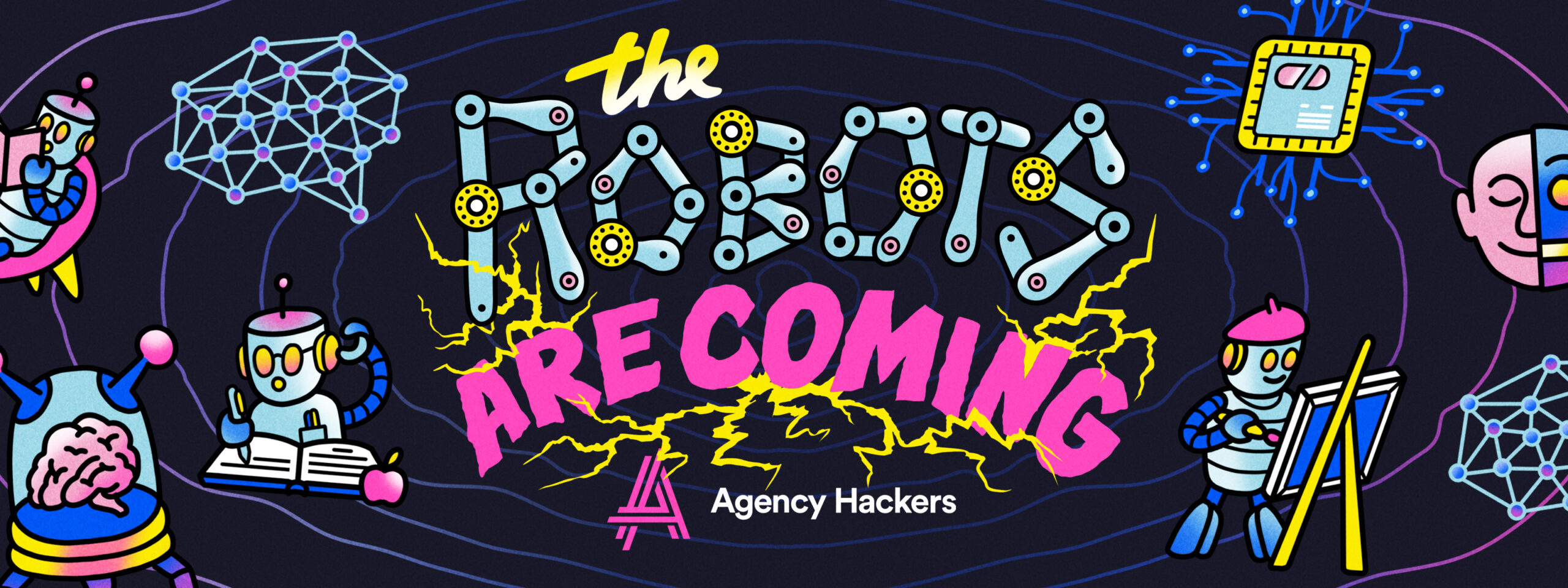Speakers
📢 Here are the current speakers we have for this event. Each of these people will be telling us – and showing us – how they are using AI in their agency today. We will also hear from you – the event is all about taking part.
How Agencies Can Leverage AI to Its True Potential?
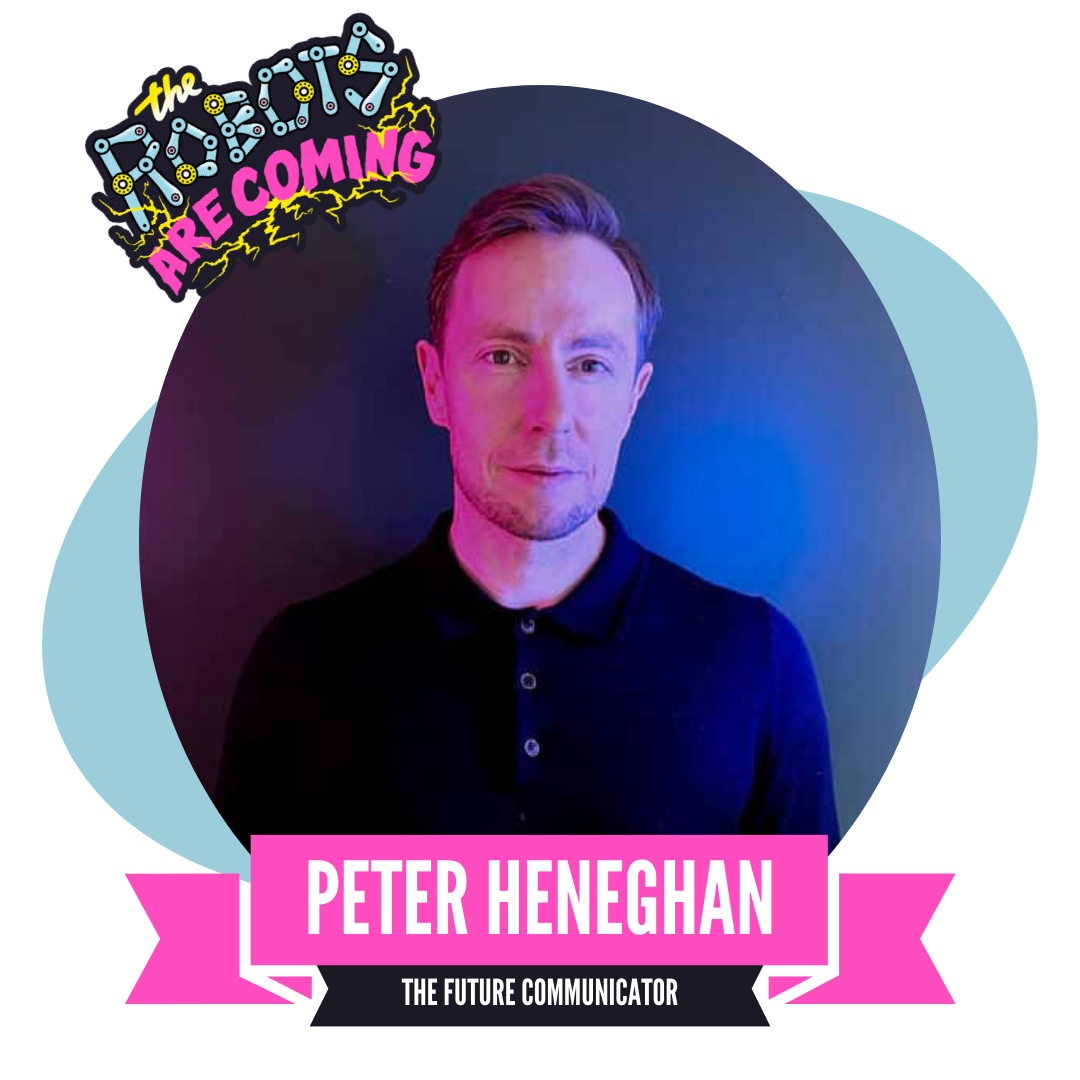
AI isn’t coming, it’s already here – and it’s here to stay.
The question is, then: are you taking advantage of it in the best way possible?
“A lot of people talk a good talk, but when it comes to it, they’re not actually using the AI tools properly,” says Peter Heneghan, founder of The Future Communicator.
“Businesses need to think differently about AI adoption. It’s not about using one or two tools – true transformation happens when humans and AI work seamlessly together across an entire organisation.”
Having been the deputy director of digital communications at 10 Downing Street, as well as working for a myriad of media giants like BBC and Channel 4, Peter is tuned into the world of AI – especially from a PR agency perspective.
He’s on a mission to get more businesses using AI through his ‘AI Halo’ framework.
It looks like this:
- Awareness and inspiration: “If you’re an agency, you want to be building a bunch of tools for either content creation, organisation, finance… everything.”
- Hands-on training: “You need to dive deep into your company’s DNA; pinpoint where AI can make the biggest impact.”
- Select the right tools: “A small agency could take on some of the biggest agencies in the world if they’ve got the right tech stack. and expertise. We could beat them at their own game.”
- Integration: “Integrating AI isn’t just about technology – it’s about people learning it.”
- Ongoing optimisation: “Adopting AI isn’t a one-and-done deal. It’s a continuous journey of optimisation and adaptation.”
ChatGPT, Claude, Midjourney: these only scratch the surface of what’s possible, and as an agency, it’s time to start developing your AI strategy.
“The businesses that win with AI will be the ‘Netflix’ of their industries,” explains Peter. “By going all-in on AI while others hesitate, they’ll disrupt legacy players and redefine what’s possible.”
At The Robots Are Coming, Peter will walk us through how your agencies can make the most out of AI, the steps you need to take to integrate it into your team and why it’s absolutely vital that you do.
Build Your Own AI Co-Pilot in 30mins

For some, the AI landscape is becoming overwhelming. New tools and AI-powered platforms seem to pop up by the second – and so many of them do the same thing.
It’s hard to know which one to choose. It’s even harder to ask about it without ruffling the feathers of AI tech gurus on LinkedIn. What you need is to be able to tell someone, or something, your problem – and get them to build you a tool to help you solve it.
Thankfully, that’s exactly what Cien Solon has done.
“AI is more than just ChatGPT and chatbots,” says Cien. “You can make the most out of it – and 10x your productivity – by building your own assistants, copilots and agents to maximise AI, monetise it, and futureproof your career, livelihood and enterprises.”
Cien has created a platform called LaunchLemonade. Designed for ‘non-techies’, it allows anyone to go in, define what they need help with, and it will generate a co-pilot to help you with that problem. Then, you can either monetise it, keep it to yourself, or share it with your team.
Cien hopes that this platform will help level the playing field when it comes to AI tech, so that everyone has the same opportunity to scale.
“We envision a future where services or products are going to be scaled through AI,” says Cien. “So right now, I can service five customers, because I have to do it manually. But if I productise this through AI, I’m able to scale hundreds, if not thousands.”
“That’s one of the core things that we want to share: this vision of getting everyone ready. These are the capabilities right now. You don’t need to know how to code. You just need an idea or your CV, or your experience or your hobbies or interests. And then we turn that into products.”
In this workshop session, Cien will show you how to create your own AI co-pilot – in tune with your specific needs – to help tackle your problems, speed up your processes, and make your job easier.
“How We Built Our Own AI Forecasting Platform“
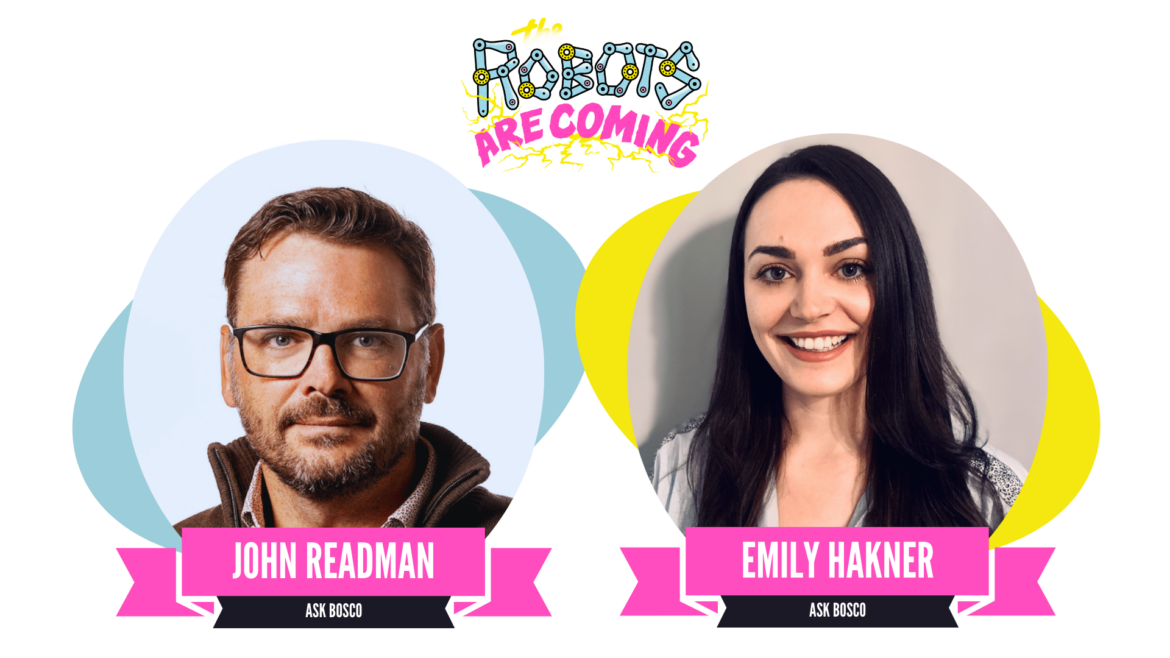
You have an idea: an idea you believe will save a lot of people a lot of pain. It’s an idea that could be made into reality through the use of AI.
But how do you make it happen? And how do you make sure you haven’t bitten off more than you can chew?
This is something John Readman, CEO and founder of Modo25, learned the hard way.
John Readman is a tech man. Despite growing and exiting several agencies, his background has always been in building software.
In his first agency, Search Laboratory, his team built a product to help clients with invoicing, billing, and bid management, as well as some tools to help the PPC team with keyword research: “But we never did anything with it – we just used it internally.”
In his second agency, Summit, John and his team built a forecasting product for retail giant Argos – which was incredibly successful: “We thought we could turn that into a product to sell to other people.”
The problem was, John had never taken any of his products or platforms public before.
“It worked really well, if you spent £2 million a month on Google, and you had 85,000 products and 800 stores,” says John. “If you didn’t spend £2 million a month on Google or have 85,000 products, it didn’t work at all.”
“But still, we tried to make it work for people. And it was a disaster.”
So when it came to creating an AI platform at Modo25, John was no longer shadowed by his naivety. (Well, almost…)
“We built it with our agency team in-house. So we split our existing team into two separate teams – one for Modo25, and one for the AI product – and the AI team was allocated money to build it.”
Now, John and his team have created an AI-powered forecasting and reporting platform for clients and agencies – called ASK BOSCO®.
“I thought we could do it in a year for a million quid – but it’s taken us £2.5 million and two and a half years,” says John. “But now we have a product that gives you unified reporting, the ability to pitch quicker, prepare decks quicker, grow your business quicker, and also retain your clients – for businesses of all shapes and sizes.”
What the Modo25 team has built is pretty impressive. But still, it came with its lessons:
- “Get user feedback earlier.”
- “Spend more time testing it before you start talking about it.”
- “It takes a lot more time and money than you think it will.”
But John says the biggest lesson of all is making sure you’re solving a big enough problem for enough people.
“AI is really well suited to solving big data problems. But developers will build a widget or a little saas product, and think that this is going to change the world. But actually, the problem isn’t big enough,” says John. “Whereas our total addressable market for ASK BOSCO® is all marketing agencies with clients who spend money on Google, or any client who does it themselves. So it’s quite a lot of people.”
In this session, John will take us through how he and his team developed his own AI-powered forecasting and reporting platform – more specifically, where he went wrong, and what he did right. He’ll be joined by his director of product, Emily Hakner, who will be on hand to give a demo of the platform, and take questions about its development.
AI FOR BEGINNERS: Easy AI Tools, Prompts & Use Cases

AI can be overwhelming – especially to a beginner. Sure, there are tool databases and how-to guides – but there’s no real cheat sheet for AI.
So in this session, we’ll be talking to some of the best in the (new) biz about the savvy ways they’re leveraging AI tools in their sales and marketing processes, and to boost their personal productivity.
One business that has gone ‘all in’ on testing LLMs for marketing is Pitch121.
“We’re using so many AI enabled tools that it can be easy to forget how it was before it came along,” says founder Laura Hannan. “I’ve personally spent a lot of time testing things on the content front, but it is also used in our sales processes.”
Laura is leading by example with AI – encouraging her team to invest time in AI research by equipping them with the support and the budget to do so.
“We now have an AI committee to not just share the testing but also to avoid the pockets of AI ‘know-how’ staying just with one department or with one person. Now we are building up our AI processes and library. The team has access to the right tools for the right job (In some cases! The testing continues) as well as budgets for testing any tool they wish.”
When it comes to testing AI tools, though, one agency leader reigns supreme: Simon Douglass, founder of Curated Digital.
In the past 12 months, Simon has tested 200 different AI tools.
Overwhelmed by the amount of choice within the AI marketplace, he set out to discover which were the best ones out there, and how they could be used in his agency – documenting his progress as he went.
Now, he’s whittled his list down to around 30 that he uses regularly.
“I usually use AI in very specific ways – mainly for productivity,” says the Curated founder. “I find it really hard to start things and I’m better at editing than creating from scratch. So I use AI as a starting point.”
Simon has found ways to speed up processes for all sorts of sales-y things, like:
- Writing SOWs – “Statements of work – I hate them, they’re a drag to put together. But you can now train ChatGPT to work to a template. So instead of it taking an afternoon, I’m able to do it in an hour.”
- Distilling client briefs – “I don’t like reading very much. So I paste client briefs into chatGPT and say, ‘What are the key things the client is looking for?’ And then I also write my garbled thoughts on how I’d approach it, and ask ChatGPT to write that up as a response.”
- Creating email marketing content – “There’s a great content writing tool I use called Hoppy Copy. You can write a bit of content, then you can choose to dial it up and make it really aggressive and sales-y, or dial it down to make it soft and fluffy.”
But the most impressive is probably his use case for proposals:
“There’s a tool called Plus, which will basically take a garbled list of random sentences and it’ll make it into a proposal document for you,” he says. “We won a big project last year, and I did about 80% of it in AI. By prompting and putting my ideas in, it wrote the whole proposal for me – and we won it. That was a big win for us.”
👉 At The Robots Are Coming, Laura and Simon will be dissecting some of the ways their business is using AI to enrich their sales and marketing efforts, increase productivity and efficiency in the agency. If you’re at the beginning of your AI journey, this session is a great starting point for you to put some more eggs in your AI basket.
How AI Literacy Can Help You Become More Creative

It seems not enough agencies truly grasp the wonder of AI.
There’s a general negative bias towards it – even from those who use it on a daily basis. You’ll hear things like, ‘It’s just a grammar tool’ or ‘It’s just a copy assistant’ – it’s ‘just this’ or ‘just that’.
But Antony Mayfield, CEO and co-founder of Brilliant Noise, says framing it in this way adds limitations to its potential. Like you’re already backing yourself into a corner by trying to put it in a box and stick a label on it.
To really get the most out of it, it’s not enough just to be open-minded – you have to be actively curious.
“It’s about discovery, not learning. We have to live in a state of discovery all of the time, because that’s the only way you’ll find anything good,” he says. “One of our mantras is ‘AI is unstoppable, but it is shapeable’.”
Antony has been following the development of AI technology longer than most agency leaders. So enthused about its potential, he and his team made the decision to pivot their agency last year to a digital innovation agency specialising in AI. Now, they’re delving into how they can create AI products for clients and upskill them on how to use them – like an AI confidante.
One of the most mind-blowing examples Antony developed came from the question: ‘What if I got two bots to talk to each other?’
“I created a bot [bot 1] with the brief and everything I knew about the client. And then I created a bot [bot 2]with everything I knew about the subject to make the response. I put all of the research into it – industry articles, old stakeholder interviews – and then I got bot 2 to create an outline of the project.”
“Then I got bot 1, which I’d made up to be like the client, to attack it and tell me all the bits that could be better. And then I made it better, and the client bot attacked it again. And in that loop, we started to get something really incredible.”
This kind of thinking only comes with a certain level of AI fluency – or ‘literacy’ as Antony calls it.
“It’s like learning a new language. In theory, you could learn GCSE French – but good luck in Paris with that,” he says. “I can speak Spanish to an A-Level standard, but put me in front of an actual Spanish speaker, I’m lost. However, I could find my way around – I’ve still got an advantage. So I have a degree of literacy.”
Project that onto AI and it looks like this: “I know enough about how this works and about how my brain works, that when I approach this task, I can do it better with the AI as part of my thinking system.”
👉 At The Robots Are Coming, Antony will show us how developing your ‘AI literacy’ can unlock a new world of creativity – which you can use to take your AI usage even further. He’ll provide interactive examples of how you transform your approach to AI to get much better and more bespoke results.
How To Protect Your IP From AI Thieves
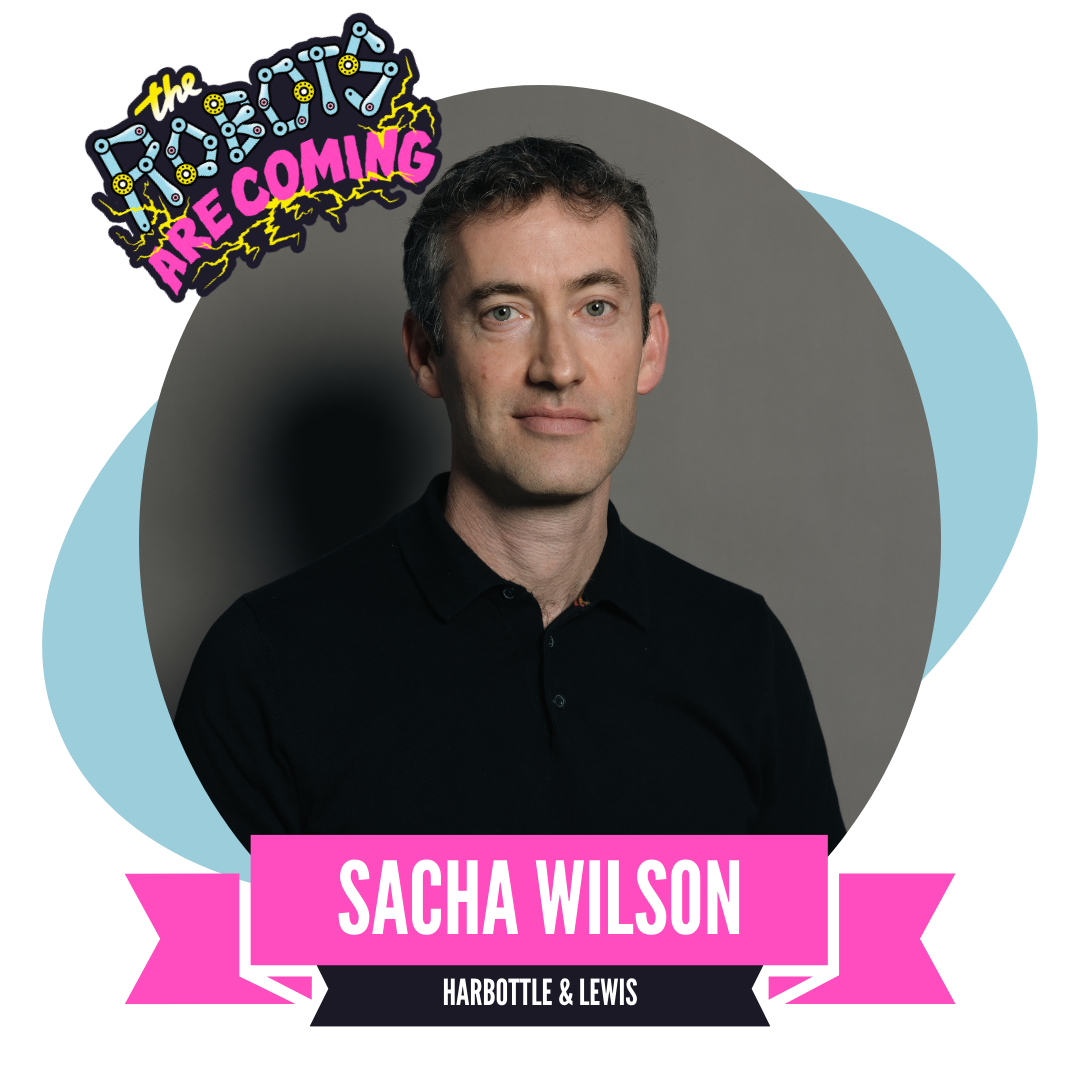
While the majority of agency land gets carried away with the excitement of AI development, there are a cautious few concerned about the impact this tech will have on the wider industry.
They’re worried about data breaches, cancelled projects, high expectations and IP thieves.
The scariest part is: they’re right. This stuff is already happening.
“We had a client approach for a rebrand. It was a household brand – pretty iconic,” says Ben Wild, founder and CEO of Ben Wild Studios. “We sent our costs, and it got to the point where the project was essentially agreed.”
Then, a week before the project was due to start, Ben got an email from the client that read: “Our junior designer put some prompts into mid journey and we’re going to go with that.”
Not good.
“The issue I had with it was, why engage so much with a company, and then change your mind so drastically, almost on a whim? It’s quite alarming.”
But this wasn’t a one time thing. It happened again, and again, and again.
“There was another project that was essentially green-lit – funds had been agreed and we’d sent the first contract over too,” says Ben. “Then we got an email from the marketing manager that said, ‘At the moment, we’ve decided to develop the 2d concepts in house using our specialist AI service. But you’ll be pleased to know we used your work as a prompt’.”
“So I have to feel grateful because you’ve essentially stolen my work?”
The problem is: IP doesn’t cover AI, because IP laws are designed to protect the rights of human creators and inventors, not non-human entities like AI systems. Not to mention the speed at which this tech develops – the law just wouldn’t be able to keep up.
More and more agencies are finding themselves in this position.
So what are your options?
In this session, we’ll be joined by Sacha Wilson, partner at Harbottle & Lewis, who specialises in advertising, digital media and data privacy legislation. Sacha deals with cases like this on a daily basis. He’ll be on hand to address how you can protect your agency’s IP from AI thieves, as well as how to prevent clients from rescinding projects in favour of AI.
How to Develop an AI Strategy for Your Business
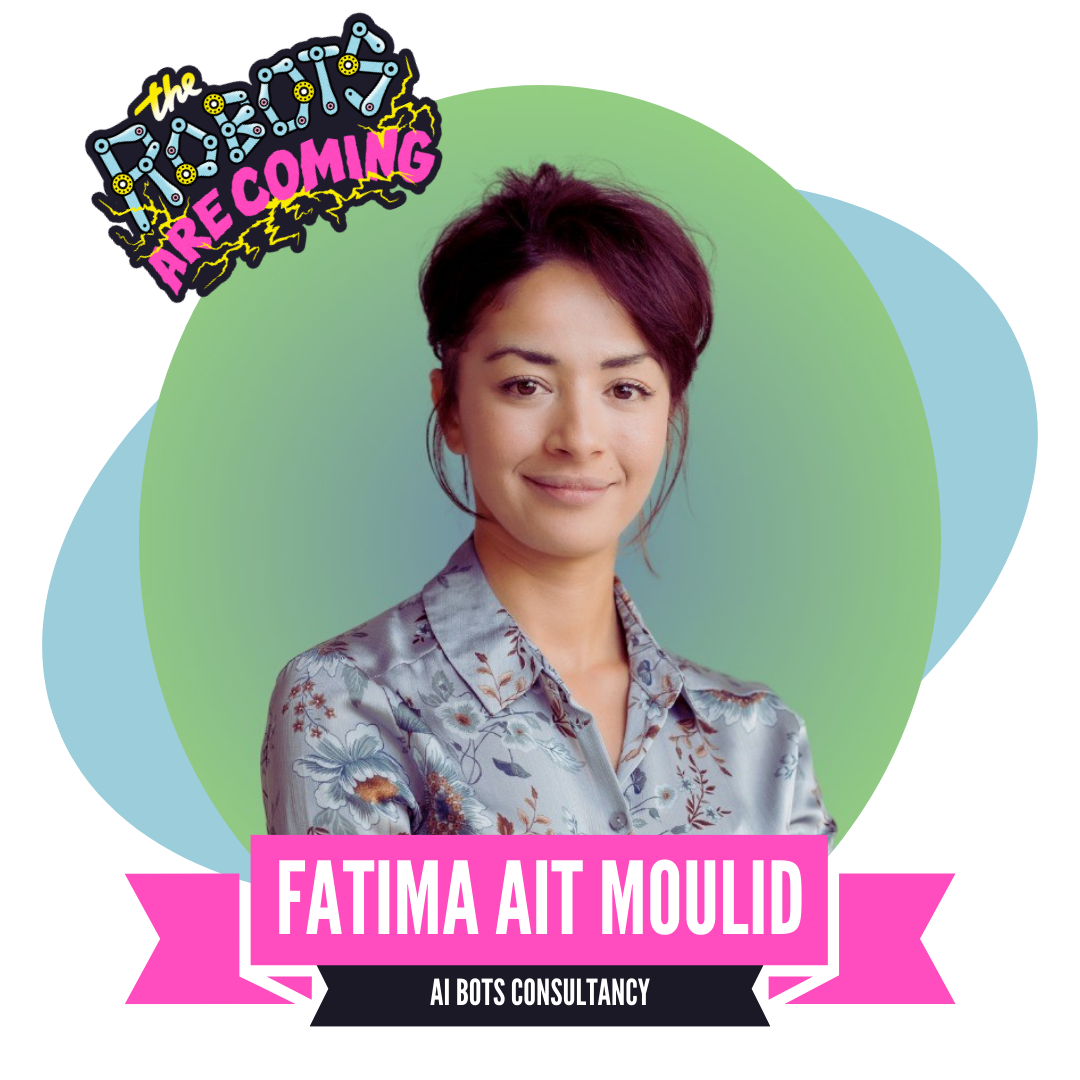
So many agencies get stuck at the ideas stage when looking at how to use AI in their business.
How do you get your AI vision out of your head and into the real world?
Fatima Ait Moulid says: if you want to do it properly and successfully, you have to come up with a strategy.
“A lot of businesses have an idea what they’d like to do with AI – but they don’t know what should come next, or they perhaps don’t have the team to help power the roll-out. And most don’t know the risks that can come with rolling out AI.”
Fatima says the risk is always the elephant in the room. AI integration can get expensive very quickly – not just in terms of money, but also time and resources.
“Businesses looking for a quick fix for this kind of digital transformation will be disappointed,” says Fatima. “My clients often want to see immediate results. But they forget that it’s an iterative process. It’s not one project – it’s about integrating it into your operating model.”
Fatima has guided countless businesses through digital transformations. So she understands that it’s not about ‘quick fixes’, but an ongoing process of evolution and innovation.
In this workshop session, Fatima will empower you to:
- Craft a tailored AI strategy: A roadmap that aligns with your agency’s unique goals and culture.
- Unlock hidden productivity: Discover how AI can augment your team’s creativity and efficiency.
- Implement with confidence: Learn the proven steps for seamless tech implementation.
- Build a culture of innovation: Empower your team to become AI champions, constantly seeking new opportunities to leverage this powerful technology.
If you’re looking to go ‘all in’ on AI in your agency – come along and create your own agency AI strategy tailored to your business, that you can implement immediately.
“How We Used AI to 12x Our Profits”
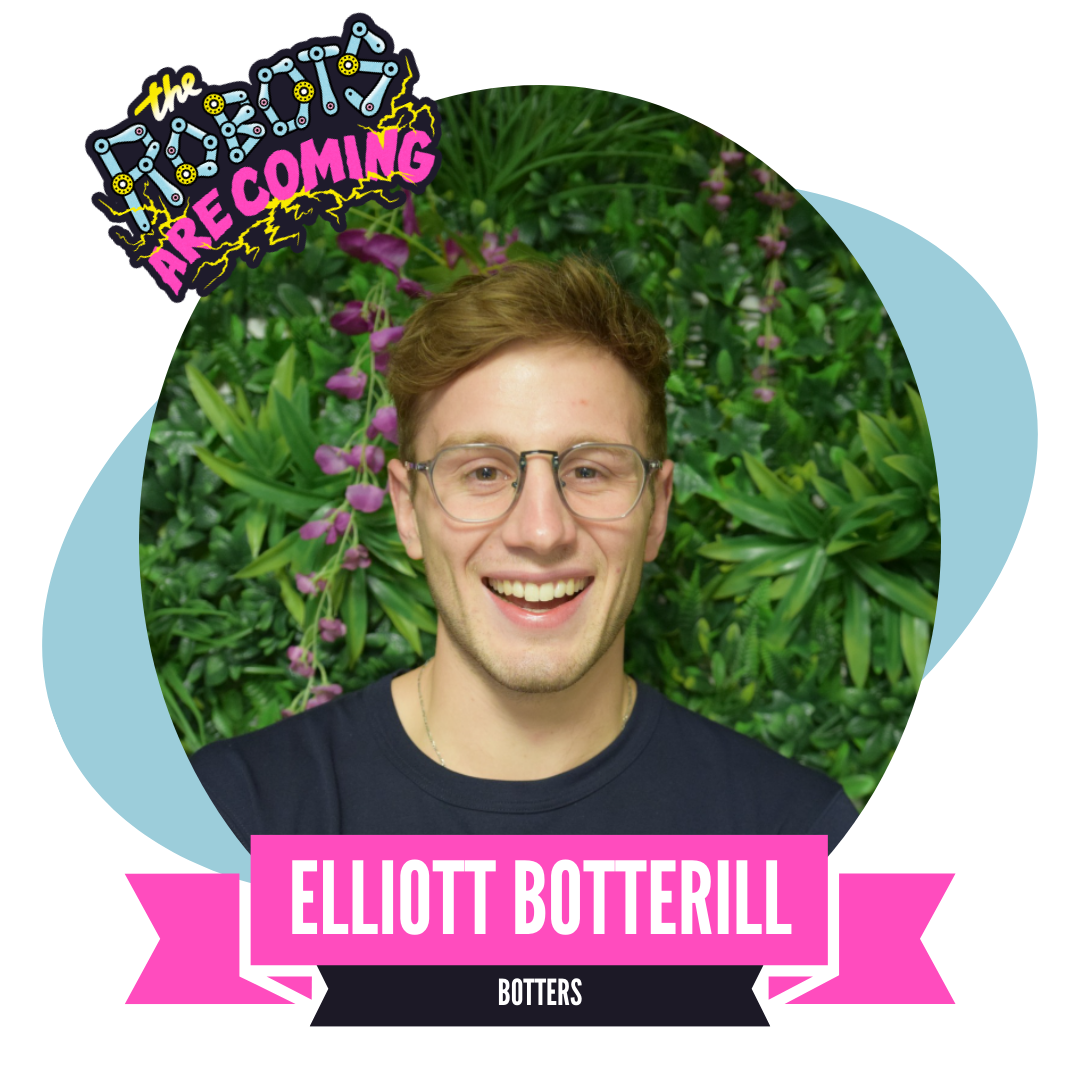
It’s 2024, and AI has become the ultimate bright and shiny object that agencies are constantly dazzled by.
But if you don’t find ways to use it to drive your business forward, it will prove futile.
“I look at AI to do one of two things for us,” says Elliott Botterill, founder of BOTTERS. “It should either increase our efficiency and enable us to do more without sacrificing quality – and in many cases, improve the quality. Or secondly, adding additional value.”
There are some who believe that the use of AI results in the sacrifice of quality. Elliott and his team are living proof that isn’t the case.
“AI completely transforms our capacity in terms of revenue per employee,” explains Elliott. “Now you can feasibly double your client count with the same number of people, and the quality of the work you deliver for them actually goes up as well.”
In fact, BOTTERS’ clients are even more satisfied now and are experiencing a higher output at a better quality and boosting profits x12.
This wasn’t achieved through sheer luck, but through rigorous testing and research and hard work.
“When I discovered the possibilities of AI, I just went down a crazy rabbit hole. And I’m naturally very inquisitive and curious – that’s how to win with AI. Be curious. Ask it things and understand what it can and can’t do.”
At The Robots Are Coming, Elliott will be delving into how he and his team have used AI to work more efficiently – and increase the agency’s bottom line.
What Should Your Agency’s AI Policy Look Like?
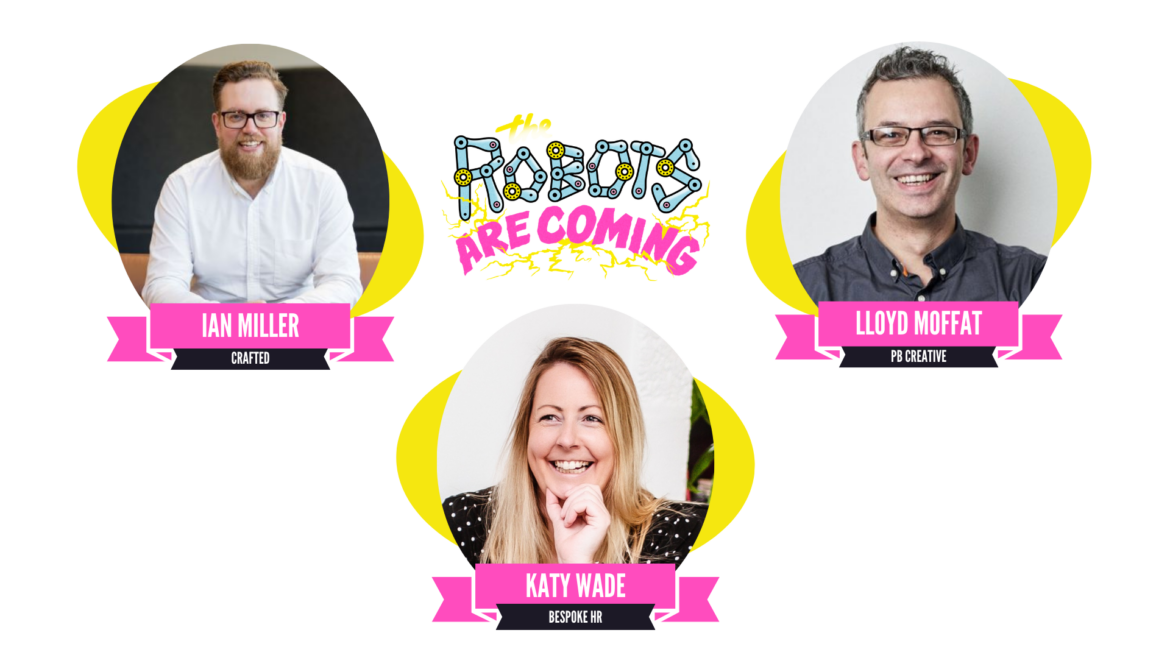
When it comes to AI, many people believe honesty is the best policy. And some agencies have gone as far to create guidelines on how to use AI within their business.
One of those agencies is Crafted.
Founder Ian Miller was preparing for an AI wave to engulf the world around 18 months before it actually happened. Because of that, he started getting some speaking gigs around the topic of AI.
From there, the agency’s AI policy began to blossom.
“Sam, my head of marketing, told me, ‘If we’re going out and talking about AI at events, or putting out thought leadership, it kind of feels a bit disingenuous to not have our own guidelines’,” says Ian.
Transparency runs through the veins of the business – Crafted is an ISO 9001 accredited agency, and also has an impact report published on its website – so reporting on AI usage was kind of a no-brainer.
But actually writing it down was a little trickier. So they borrowed some inspiration from further afield.
“Last year, a few brands were starting to publish AI guidelines,” says Ian. “For example, Getty was saying what it would and wouldn’t allow. And there was one that came from a US-based PR agency that we really like the tone of – it felt like us. So Sam used that to make the first draft of the guidelines.”
So what exactly do the guidelines cover?
“We’re not going to suddenly create some need for something that we don’t actually have,” Ian says. “I’m seeing that a bit in agencies where they’re like, ‘Oh we’ve got this, we’ve got that’, but do you actually use it? Is it actually going to help us or does it just seem cool?”
“So our team will use a tool if it’s applicable.”
As more and more brands continue to integrate AI tech into their products – like Google, Microsoft and Adobe – it’s fair to assume that, soon enough, everyone will be using AI in their day-to-day. So now is as good a time as ever to craft a policy for your team on how to use it.
“You’ve got predictive fill on Photoshop; you’ve got predictive emails in Gmail. These things are AI, but they’re within the workflow that you have. And that’s what is reflected in our guidelines.”
“The tone of it is, we’re not going to go and find new technology for technology’s sake. But AI is an enhancement on the process. There’s a reason why all accountants use Excel now rather than abacuses.”
At The Robots Are Coming, Ian will join us alongside BespokeHR’s Katy Wade and PB Creative’s Lloyd Moffat to discuss what your agency’s AI policy should look like, what it should include, and how you can get started on developing your own.
“How We Built Our AI Research & Development Team”
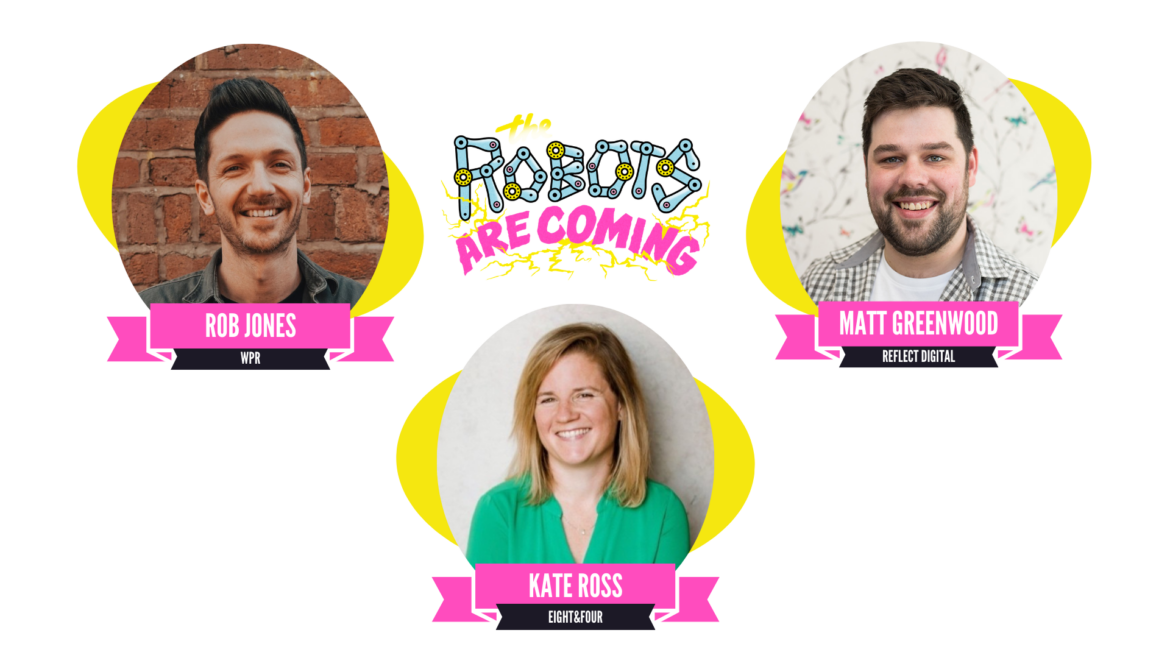
AI is evolving fast; dabbling doesn’t cut it anymore. You’ve got to put in the time – and do your research.
In fact, some agencies have even started to build their own AI research and development teams in order to stay ahead of the curve.
In this session, we’ll be bringing three voices from different agencies to discuss why and how you can create a dedicated AI research and development team, as well as looking at how it’s worked out for them.
Meet your panellists:
Matt Greenwood – SEO manager at Reflect Digital
Towards the end of last year, Reflect Digital decided to set up a small AI working group. Why?
- To keep up with AI’s constant evolution.
- Clients wouldn’t stop talking about AI.
- To ensure they continued to approach AI with a human-first mentality.
“We knew that AI would be a huge thing for the industry as a whole,” says Matt. “So we started by asking ourselves two questions: How can we implement AI in our work, and what is Reflect’s stance on AI?”
“It initially started working through these very open ended discussions on what we think the impact, risks and opportunities would be both to us and to clients. As those conversations developed, we started looking at it more practically.”
Here’s how it works:
- Individual research projects – Each member of the working group (who come from different departments) selects an AI project or tool that aligns with their role, and they research them independently.
- Regular group meetings – The group meets every two weeks to discuss their findings and recommendations for the business.
- Wider company sharing – Every quarter, the group presents its progress to the company to keep everyone informed and engaged with their work on AI.
Kate Ross – co-founder and MD at eight&four group.
“We don’t have an AI team. Everybody does AI.”
2024 has seen eight&four pivot into being a fully GenAI enabled agency, and after they built their groundbreaking image generator AI, ‘Coach’, Kate might now be AI’s biggest champion.
But rather than setting up a single, dedicated AI research team, they’ve taken a proactive, hands-on approach.
“We posted about ChatGPT 3.5 launching on Slack in 2022, and very quickly we had a big AI channel which is open to everybody,” says Kate. “It has been really critical, because from that a group of curious people started to lead in the AI space.”
“We’ve found that people are so sensitive to the idea of being excluded from an AI team, so we’ve kept it all open,” she says. Everybody needs to think about it; it’s in everybody’s job role and objectives.”
Rob Jones – associate B2B director at WPR Agency
On the other end of the AI spectrum is WPR – before they even began to use AI in any capacity, they wanted to ensure they had a solid grip on its capabilities.
“We have an AI taskforce in place that is researching, testing and reviewing various different AI tools and platforms,” explains Rob Jones.
“We have people from different facets of our business exploring how AI can be applied in their areas, and we’ve got some test exercises planned where we’re going to use AI for tasks like writing press releases, doing research, and coming up with social content.”
This approach stems from the first iteration of their AI policy, which Rob says was “pretty prohibitive”.
He admits that they’re not fully comfortable using AI for client output yet, but they do intend to use it to improve their research processes, early-stage iterative work, and to shape the development of that AI policy moving forward.
If you’re thinking of building an AI research team in your agency but not quite sure where to start, come along to this session at The Robots Are Coming and find out how!
If you’re thinking of building an AI research team in your agency but not quite sure where to start, come along to this session at The Robots Are Coming and find out the steps you need to take.
“How We’re Leveraging AI Tools On a Budget“
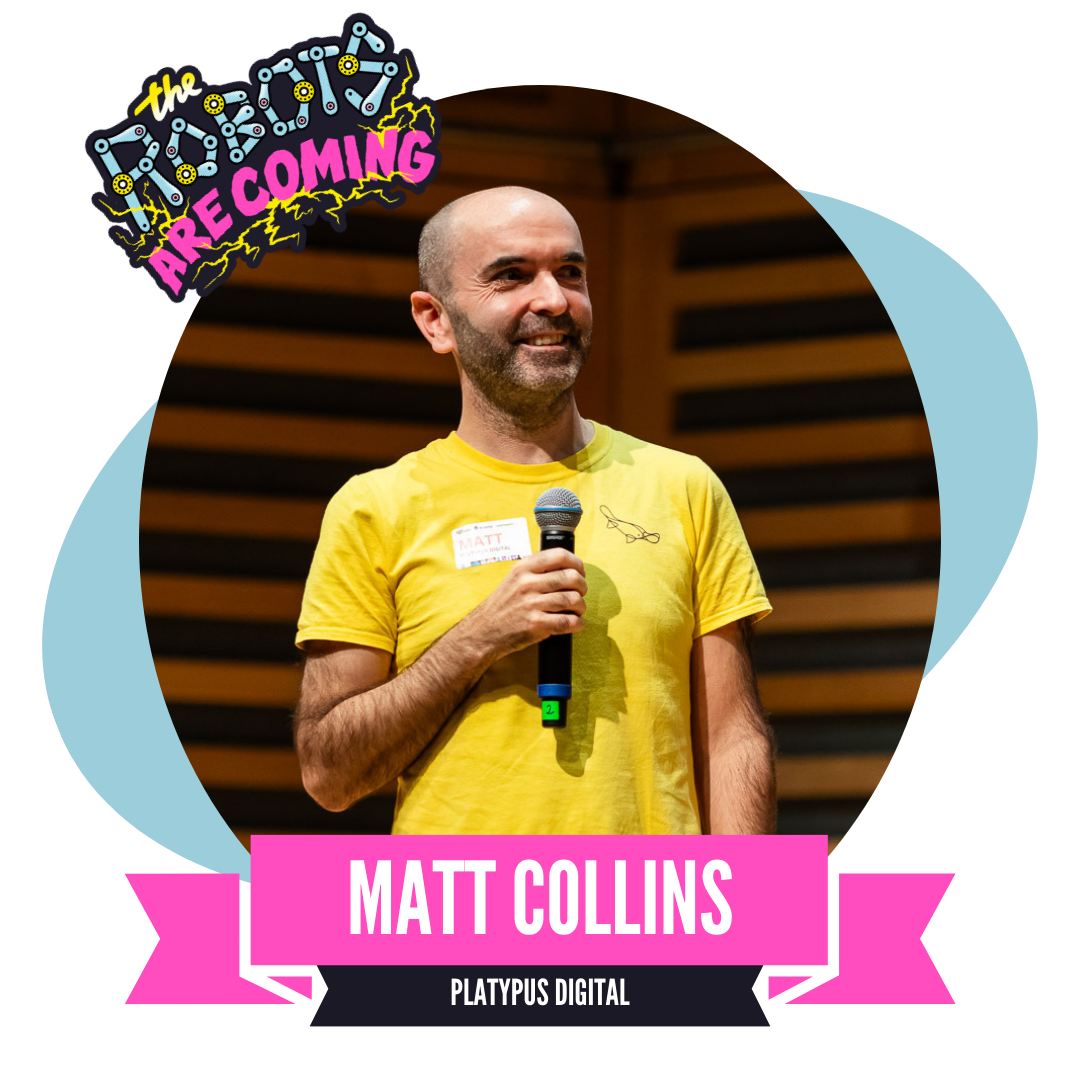
At the beginning of 2024, Matt Collins was diagnosed with Parkinson’s.
He had developed a tremor in his left hand that made it difficult to use them as a pair: “I could no longer type with two hands.”
It began to interfere with work. As the founder, he was in charge of all of the marketing for the business: blogs, social media, email marketing – the lot.
So he started looking for tools to help him. During his search, he came across SuperWhisper.
“Super Whisper is a free, AI-powered dictation app – and it’s much better than any other dictation app on the market,” says Matt. “I’ll just say what I want to say and it’ll format that into sentences and capitalisation. Then, when you enable AI, you can connect it to Claude or ChatGPT or any other LLM, including local LLMs, and you can do a voice prompt.”
“For example, I could say, ‘Email this person, tell them it was good to meet and give them an interesting fact that they might not be aware of’. Then, it’ll send you a well-formatted email in about five seconds.”
The trick to success with Super Whisper is getting the pre-prompt settings right. This is essentially a background prompt within system preferences. You can add a ‘standard prompt’ that you’d like to use every time.
Some of Matt’s include:
- Use UK spellings, not US.
- Paragraphs must be 1-2 sentences.
- Use a sprinkling of emojis to show friendliness.
- Short sentences, action-focused.
- Don’t use words like best or best wishes.
And there’s a section for copy examples too – so you can copy and paste examples of your writing in emails or social posts, and it will copy that format and tone.
“You can use it for lots of things, like sales outreach, or creating some really great content really, really fast – and it’s all formatted in the way that you want, using your tone of voice,” says Matt.
“It’s a massive lifesaver. Particularly on days where I don’t feel like me – if I just have that prompt in there, then I’ll always have that kind of chirpy tone.”
Matt had caught the bug. Already a fan of Claude, he began to document various writing prompts that he calls ‘content creation jump-off points’.
“People say you can’t use LLMs for content creation, but I would say it augments 70-80% of the process,” he says. “We’re not at the point where we’re using it to write all our content, but it’s definitely a good start.”
It’s not just content creation, either. Matt has been able to leverage these tools to help him with client calls, sales pitches – and even competitor analysis.
But the biggest timesaver of all is using it for proposals.
“I did one recently, and it came up with ideas I wouldn’t really have come up with. They were super specific, and tailored to the brief. So it’s augmenting the ideas as well as just formatting and repurposing.”
“Proposals take me way less time now. I can get more done and they’re better quality too, because I’m drawing on a source of knowledge I didn’t have before. It’s like I’ve got this expert assistant sitting next to me, taking the role of a sales director who’s better at this stuff than I am, and using their ideas to make mine better.”
“It just makes the quality of our offering that much higher, because of the knowledge that each of those models are tapped into.”
At The Robots Are Coming, Matt will take us through how he’s using public LLMs to supercharge his agency’s sales and marketing – from blog content and LinkedIn posts, to client proposals and competitor analysis – without breaking the bank.
How To Harness AI in Digital Marketing
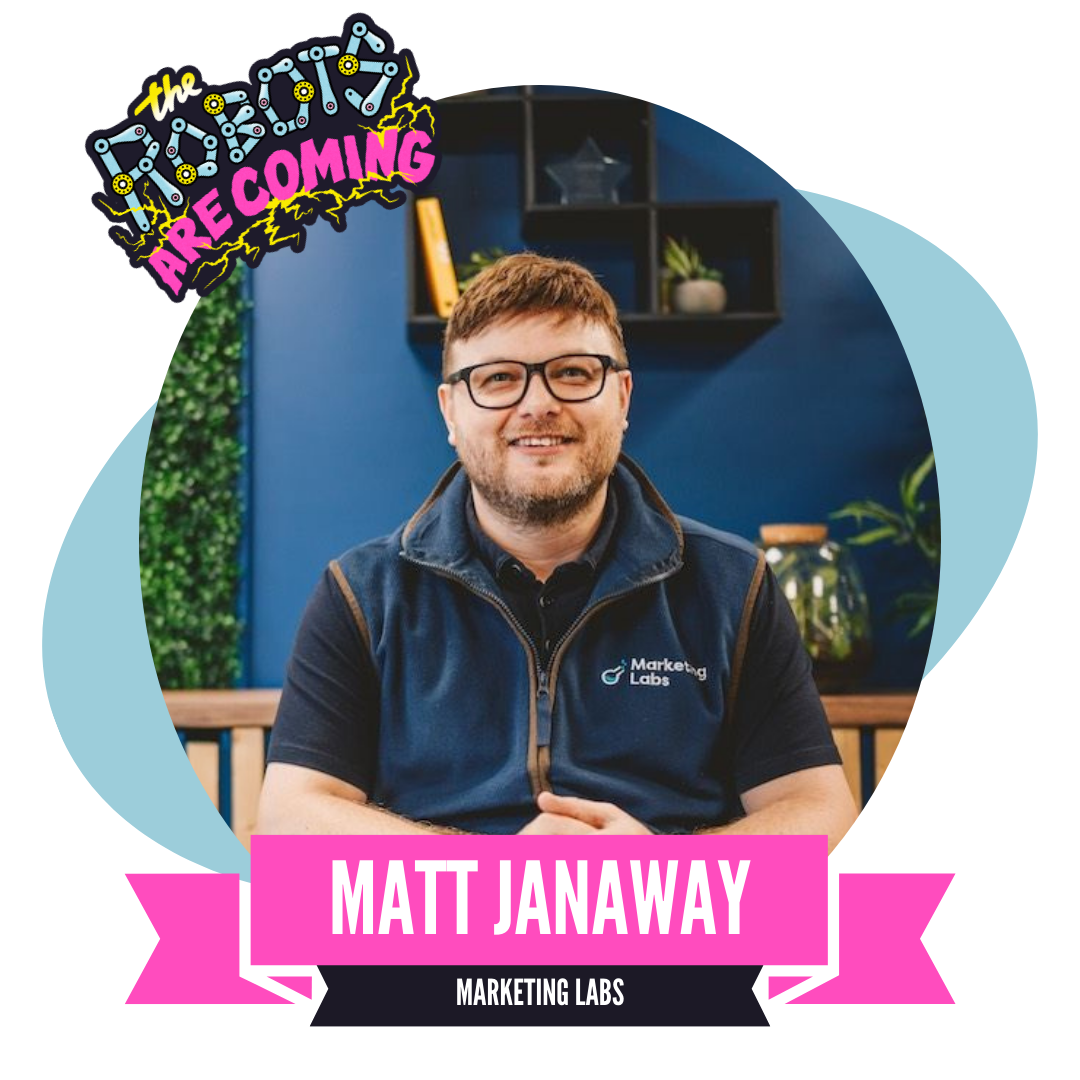
“I’ve been in digital marketing long enough to realise that there are just many turning points – and for every single one of them, everybody said, ‘Digital marketing is finished. SEO is dead’. But it’s not, you just have to adapt,” says Matt Janaway, CEO of Marketing Labs.
Matt Janaway has been in the SEO business since he was 16 years old. He’s seen trends come and go, yet the industry, and his business, is still standing.
So while others are concerned AI will see the death of digital marketing, how is Matt’s agency – and its clients – still growing?
“Of all of the changes within digital marketing, there’s probably been about ten in the past 20+ years that are really big – where people were panicking about the future of digital marketing,” says Matt. “I would say there was probably some validity in some of those worries. But with AI, I actually completely disagree.”
“It’s about adapting and using those opportunities. If you can find ways of capitalising on that and making yourself more efficient, but also using it in a way that can benefit clients – that can only be a good thing, surely?”
So what exactly is Matt’s agency doing to leverage AI into its service offering?
“We’ve been playing around with AI for probably five years now,” says Matt. “We’ve built some of our own LLMs, and have them working on internal machines to do various tasks, and we’ve been building ways to save countless hours of time filtering through data to look for optimisations.”
But the AI-powered process Matt’s team has built that has had the most impact is for website migration.
“The average website migration is, say, a few 100 pages. Normally, that process would take us three or four working days to go through all the data. We’ve now managed to get that down to about two or three hours.”
“Processes like these have certainly saved us a huge amount of time, which we can then use to spend on clients. So in that case, it’s had an indirect impact on our growth. We have more capacity, which means we can sell more time.”
In an industry like digital marketing, AI can have a profound impact on the time it takes to deliver certain projects. But it can be tricky to know where to start – which part of the process should you look at automating first?
“It’s those use cases where a client doesn’t really see value in paying you to do it, but they haven’t got the time or the expertise to do it themselves. In situations like that, there’s usually an AI solution.”
In this session, Matt will take us through how his agency has been integrating AI into its services for the last five years – from speeding up processes to addressing client pain points – and how you can start to do this too.
TOOL SHOW & TELL: Building AI Tools In-House
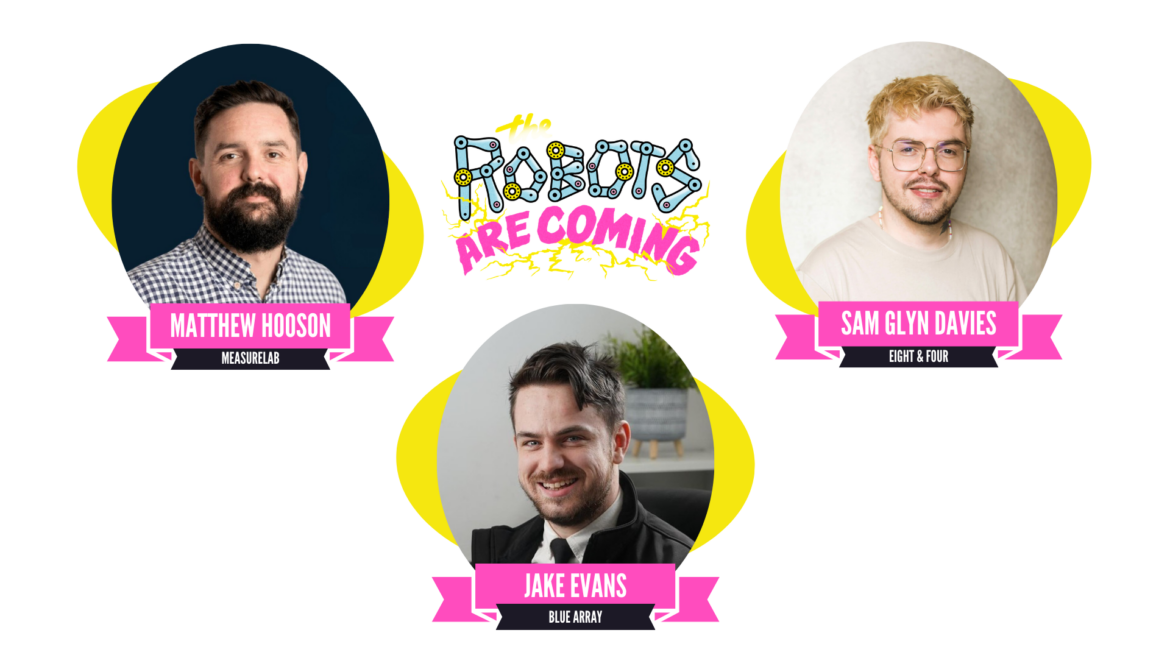
ChatGPT – as well as the myriad other AI tools out there – is great, there’s no denying it. But if you’re an agency, the best way to advance in AI is by creating your own.
Public AI tools can either be:
- Too broad.
- Too inaccurate.
- Too uncontrollable.
So, if you want a thing done right, do it yourself.
One person who has done this already is Measurelab’s Matthew Hooson – who has created his own AI chatbot named BRIAN.
“I didn’t want BRIAN to be considered just another bot – I wanted something more intelligent that stood out,” says Matthew. “With how fast the pace of AI is growing, I was worried we were in danger of not acting.”
“I began to explore AI more deeply and came to the conclusion that a nice way to engage people would be for us to have our own internally branded automation and AI hub. It would be a place where people could come to make their own assistants, share resources and view tools.”
Blue Array’s Jake Evans is helping to build another AI called AskSEO, where people can upload documents and the AI will leave suggestions to ensure the content aligns with SEO best practices. Or, you can chat with the bot in real time for any quick SEO questions you might have.
“It’s really meant to bridge that gap for people who aren’t necessarily super knowledgeable on SEO,” explains Jake.
“Say you’re making an edit on a website but aren’t sure if it aligns with SEO best practice. Instead of emailing your agency and waiting hours for them to get back to you, you can just quickly chat with the chatbot, and those recommendations are backed and vetted.”
But this extends far beyond just chatbots – eight&four’s Sam Glynn Davies has created the incredible AI image generator, Coach.
Coach allows its users to upload 3D or CAD models of products, and it’ll learn its design and, by feeding it prompts, it can generate images of the product in any chosen environment.
“We did a test about six weeks ago with all the finalised images Coach had made,” eight&four told us. “We mixed them with real life images and showed them to our design teams. Now, these are art directors, very senior people, and they couldn’t tell which was real or not.”
At The Robots Are Coming, we’ll be showcasing these custom-made AI tools on the big screen, whilst really getting into how they were made. If you’re thinking of creating your own in-house AI tool but not sure where to start, come along to this workshop to get your questions answered.
